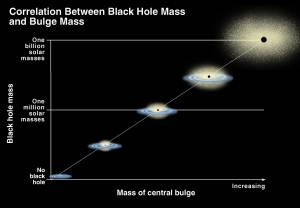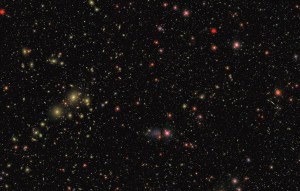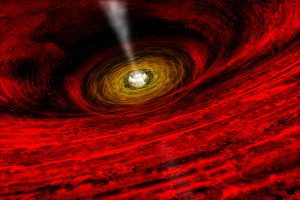|
|  |
Detailed  studies
of the motions of stars in the Galactic Center have all but
clinched the case that our own Milky Way contains a black hole with a
mass of 3 million suns. Astronomers have also been measuring black
holes in a few dozen nearby galaxies and have discovered that the mass
of the black hole is very tightly correlated with the mass of the
surrounding galactic spheroid or bulge (see fig. 1). The bulge mass
is always close to a thousand times the mass of the black
hole. Moreover, galaxies with no bulge component do not appear to
contain a black hole. This discovery is tantalizing because it
suggests that galactic spheroids and black holes must form
together. The question is then how and when did this formation occur?
Is it possible to find direct evidence that bulges and black holes are
still forming in some galaxies or did most formation activity end a
long time in the past? studies
of the motions of stars in the Galactic Center have all but
clinched the case that our own Milky Way contains a black hole with a
mass of 3 million suns. Astronomers have also been measuring black
holes in a few dozen nearby galaxies and have discovered that the mass
of the black hole is very tightly correlated with the mass of the
surrounding galactic spheroid or bulge (see fig. 1). The bulge mass
is always close to a thousand times the mass of the black
hole. Moreover, galaxies with no bulge component do not appear to
contain a black hole. This discovery is tantalizing because it
suggests that galactic spheroids and black holes must form
together. The question is then how and when did this formation occur?
Is it possible to find direct evidence that bulges and black holes are
still forming in some galaxies or did most formation activity end a
long time in the past?
Scientists at the Max-Planck-Institute for Astrophysics (MPA) and at
Johns Hopkins University (JHU) in the United States have been
attempting to answer these questions by studying a large sample of
 galaxies
with active nuclei in the Sloan Digital Sky Survey (see
fig. 2). In these galaxies, material accreting onto the central black
hole (see fig. 3) produces ionizing radiation that leads to
characteristic signatures in the emission line spectrum of the
galaxy. The MPA/JHU team carried out a detailed census of 22,000 such
systems in the local Universe in order to calculate the rate at which
black holes grow at the present day. The results indicate that on
average, "low mass" black holes of less than a hundred million solar
masses are still growing at a significant rate. The team also measured
the star formation in nearby low mass bulges and deduced that rate at
which new stars form in these systems is a thousand times larger than
the rate at which their black holes are growing. This factor of a
thousand is in gratifying agreement with the ratio between bulge and
black hole mass observed in inactive galaxies! By contrast, the
largest black holes in the local Universe, which have masses of up to
10 billion solar and which reside in giant elliptical galaxies, are
hardly growing at all, indicating that they must have formed at
significantly earlier cosmic epochs. galaxies
with active nuclei in the Sloan Digital Sky Survey (see
fig. 2). In these galaxies, material accreting onto the central black
hole (see fig. 3) produces ionizing radiation that leads to
characteristic signatures in the emission line spectrum of the
galaxy. The MPA/JHU team carried out a detailed census of 22,000 such
systems in the local Universe in order to calculate the rate at which
black holes grow at the present day. The results indicate that on
average, "low mass" black holes of less than a hundred million solar
masses are still growing at a significant rate. The team also measured
the star formation in nearby low mass bulges and deduced that rate at
which new stars form in these systems is a thousand times larger than
the rate at which their black holes are growing. This factor of a
thousand is in gratifying agreement with the ratio between bulge and
black hole mass observed in inactive galaxies! By contrast, the
largest black holes in the local Universe, which have masses of up to
10 billion solar and which reside in giant elliptical galaxies, are
hardly growing at all, indicating that they must have formed at
significantly earlier cosmic epochs.
The results of the MPA/JHU team give further credence to the concept
of "cosmic downsizing". Cosmic downsizing describes a scenario in which active
star formation and black hole growth occurs shifts to lower and
lower mass galaxies as the Universe evolves. This is seen
as something of a paradox by theoreticians who try to understand how
galaxies may have formed from the evolution of tiny density perturbations
generated in the earliest moments of the Universe following the Big Bang.
According to now-standard theory, the dominant matter component of the Universe
is not in the form of the ordinary baryons that make up ordinary
human beings and stars, but consists of unseen dark matter that
interacts only via gravitation. Dark matter does not undergo cosmic downsizing.
The collapse of dark matter starts on small scales and proceeds to
ever more massive structures. Understanding exactly why the
behaviour of galaxies and dark matter should be so different remains one of
the major challenges for cosmologists today.
Guinevere Kauffmann
Further Information:
 A scientific article A scientific article
 SDSS data page SDSS data page
|




